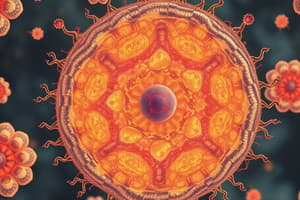Podcast
Questions and Answers
What is the main function of ribosomes in prokaryotic cells?
What is the main function of ribosomes in prokaryotic cells?
- Synthesize proteins (correct)
- Protect the cell from dehydration
- Store genetic material
- Facilitate locomotion
Where is the DNA located in prokaryotic cells?
Where is the DNA located in prokaryotic cells?
- In the nucleus
- In the nucleoid (correct)
- In membrane-bound organelles
- In the ribosomes
What structure aids prokaryotic cells in attaching to surfaces?
What structure aids prokaryotic cells in attaching to surfaces?
- Cell membrane
- Flagella
- Nucleoid
- Capsule (correct)
What is a key difference between prokaryotic and eukaryotic cells?
What is a key difference between prokaryotic and eukaryotic cells?
What is the role of flagella in prokaryotic cells?
What is the role of flagella in prokaryotic cells?
Which component is NOT typically found in prokaryotic cells?
Which component is NOT typically found in prokaryotic cells?
What substance is commonly found in the cell wall of most prokaryotes?
What substance is commonly found in the cell wall of most prokaryotes?
How do pili function in prokaryotic cells?
How do pili function in prokaryotic cells?
What is the primary purpose of the cell wall in prokaryotic cells?
What is the primary purpose of the cell wall in prokaryotic cells?
What role do fimbriae serve in prokaryotic cells?
What role do fimbriae serve in prokaryotic cells?
Which component of prokaryotic cells is involved in genetic exchange during conjugation?
Which component of prokaryotic cells is involved in genetic exchange during conjugation?
What is the primary purpose of the peptidoglycan cell wall in prokaryotes?
What is the primary purpose of the peptidoglycan cell wall in prokaryotes?
Prokaryotic cells lack which of the following structures?
Prokaryotic cells lack which of the following structures?
Where is the genetic material located in prokaryotic cells?
Where is the genetic material located in prokaryotic cells?
Which statement about the capsule in some prokaryotic cells is true?
Which statement about the capsule in some prokaryotic cells is true?
Which of the following structures is NOT seen in all prokaryotic cells?
Which of the following structures is NOT seen in all prokaryotic cells?
What characteristic distinguishes prokaryotic cells from eukaryotic cells?
What characteristic distinguishes prokaryotic cells from eukaryotic cells?
In prokaryotic cells, what is the primary function of ribosomes?
In prokaryotic cells, what is the primary function of ribosomes?
Flashcards are hidden until you start studying
Study Notes
Common Components of Cells
- All cells possess four key components: a plasma membrane, cytoplasm, DNA, and ribosomes.
- The plasma membrane acts as a barrier, separating the cell's interior from the external environment.
- Cytoplasm consists of a jelly-like substance called cytosol, housing various cellular components.
- DNA serves as the cell’s genetic material, providing instructions for function and reproduction.
- Ribosomes play a critical role in synthesizing proteins essential for cellular activities.
Characteristics of Prokaryotic Cells
- Prokaryotes are predominantly unicellular organisms, lacking a nucleus and membrane-bound organelles.
- Prokaryotic DNA is located in the nucleoid, a region within the cell that is not enclosed by a membrane.
- The generalized structure of prokaryotic cells includes chromosomal DNA, ribosomes, a plasma membrane, and typically a cell wall.
Cell Wall and Capsule
- Most prokaryotes have a peptidoglycan cell wall that provides structural support and protection.
- The cell wall maintains cell shape and prevents dehydration.
- Many prokaryotes also possess a polysaccharide capsule that aids in adhering to surfaces in their environment.
Specialized Structures
- Certain prokaryotes are equipped with flagella for movement.
- Pili facilitate the exchange of genetic material during conjugation, allowing for genetic transfer between bacteria.
- Fimbriae assist in attachment to host cells, playing a crucial role in bacterial colonization.
Common Components of Cells
- All cells possess four key components: a plasma membrane, cytoplasm, DNA, and ribosomes.
- The plasma membrane acts as a barrier, separating the cell's interior from the external environment.
- Cytoplasm consists of a jelly-like substance called cytosol, housing various cellular components.
- DNA serves as the cell’s genetic material, providing instructions for function and reproduction.
- Ribosomes play a critical role in synthesizing proteins essential for cellular activities.
Characteristics of Prokaryotic Cells
- Prokaryotes are predominantly unicellular organisms, lacking a nucleus and membrane-bound organelles.
- Prokaryotic DNA is located in the nucleoid, a region within the cell that is not enclosed by a membrane.
- The generalized structure of prokaryotic cells includes chromosomal DNA, ribosomes, a plasma membrane, and typically a cell wall.
Cell Wall and Capsule
- Most prokaryotes have a peptidoglycan cell wall that provides structural support and protection.
- The cell wall maintains cell shape and prevents dehydration.
- Many prokaryotes also possess a polysaccharide capsule that aids in adhering to surfaces in their environment.
Specialized Structures
- Certain prokaryotes are equipped with flagella for movement.
- Pili facilitate the exchange of genetic material during conjugation, allowing for genetic transfer between bacteria.
- Fimbriae assist in attachment to host cells, playing a crucial role in bacterial colonization.
Studying That Suits You
Use AI to generate personalized quizzes and flashcards to suit your learning preferences.




